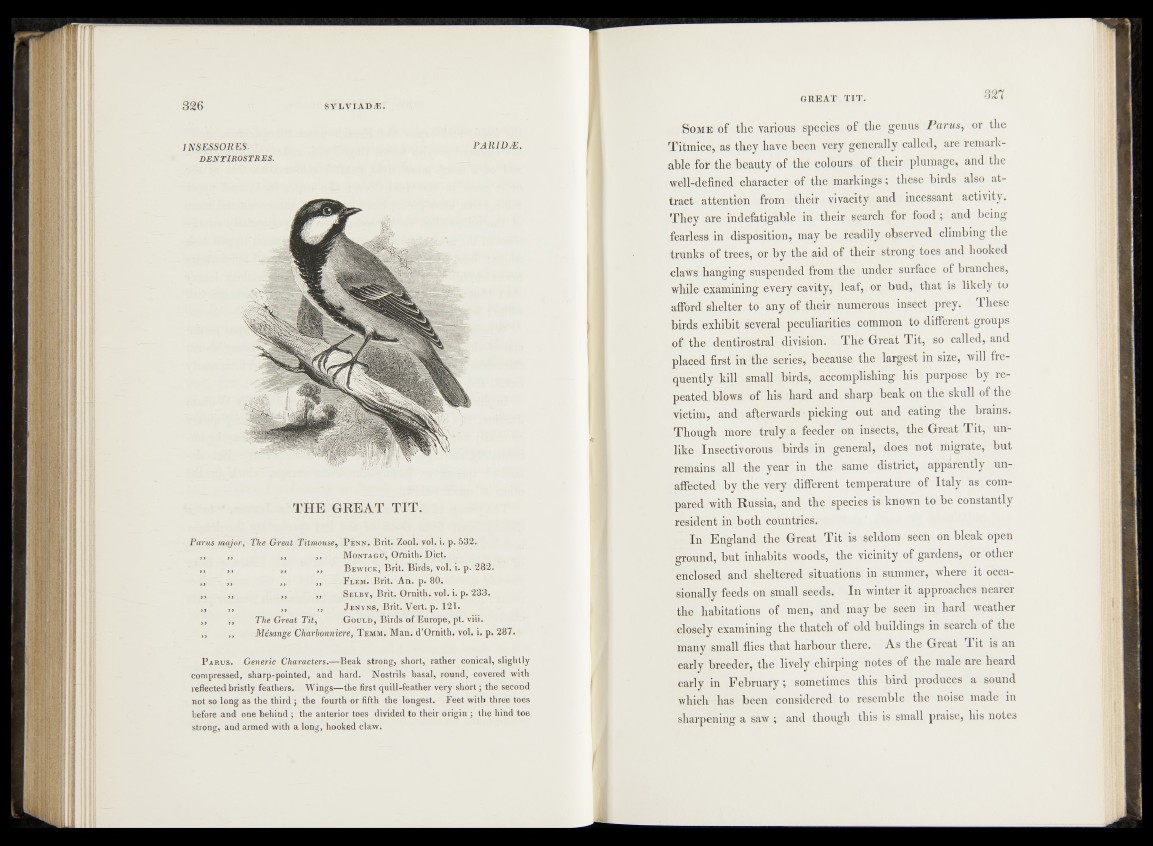
J NS ESSO RES. PAU1DÆ.
DENTIROSTRES.
TH E GREAT T IT .
Parus major, The Great Titmouse, P enn. Brit. Zool. vol. i. p. 532.
,, ,, ,, ,, Montagu, Ofnith. Diet.
,, ,, ,, „ Bewick, Brit. Birds, vol. i. p. 282.
,, ,, „ ,, Flem. Brit. An. p. 80.
,, ,, ,, ,, Selby, Brit. Ornith. vol. i. p. 233.
,, ,, ,, ,, J enyns, Brit. Vert. p. 121.
,, „ The Great Tit, G ould, Birds of Europe, pt. viii.
,, ,, Mésange Charbonnière, T emm. Man. d’Ornith. vol. i. p. 287.
P arus. Generic Characters.—Beak strong, short, rather conical, slightly
compressed, sharp-pointed, and hard. Nostrils basal, round, covered with
reflected bristly feathers. Wings—the first quill-feather very short ; the second
not so long as the third ; the fourth or fifth the longest. Feet with three toes
before and one behind ; the anterior toes divided to their origin ; the hind toe
strong, and armed with a long, hooked claw.
S o m e of the various species of the genus Petrus, or the
Titmice, as they have been very generally called, are remarkable
for the beauty of the colours of their plumage, and the
well-defined character of the markings; these birds also attract
attention from their vivacity and incessant activity.
They are indefatigable in their search for food; and being
fearless in disposition, may be readily observed climbing the
trunks of trees, or by the aid of their strong toes and hooked
claws hanging suspended from the under surface of branches,
while examining every cavity, leaf, or bud, that is likely to
afford shelter to any of their numerous insect prey. These
birds exhibit several peculiarities common to different groups
of the dentirostral division. The Great Tit, so called, and
placed first in the series, because the largest in size, will frequently
kill small birds, accomplishing his purpose by repeated
blows of his hard and sharp beak on the skull of the
victim, and afterwards picking out and eating the brains.
Though more truly a feeder on insects, the Great Tit, unlike
Insectivorous birds in general, does not migrate, but
remains all the year in the same district, apparently unaffected
by the very different temperature of Italy as compared
with Russia, and the species is known to be constantly
resident in both countries.
In England the Great Tit is seldom seen on bleak open
ground, but inhabits woods, the vicinity of gardens, or other
enclosed and sheltered situations in summer, where it occasionally
feeds on small seeds. In winter it approaches nearer
the habitations of men, and may be seen in hard weather
closely examining the thatch of old buildings in search of the
many small flies that harbour there. As the Great Tit is an
early breeder, the lively chirping notes of the male are heard
early in February; sometimes this bird produces a sound
which has been considered to resemble the noise made in
sharpening a saw ; and though this is small praise, his notes